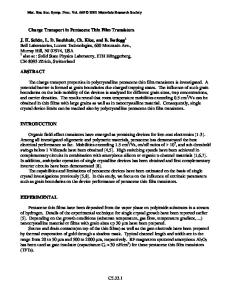Charge transport in solution-processed zinc tin oxide thin film transistors
- PDF / 355,721 Bytes
- 7 Pages / 584.957 x 782.986 pts Page_size
- 93 Downloads / 311 Views
Zinc oxide-based transparent amorphous oxide semiconductors (TAOS) are strong contenders to replace amorphous and polycrystalline silicon for large area display backplanes due to their high electron mobility. To enable future roll-to-roll printed electronics, solution-processed fabrication methods are needed. Here, we use low-temperature measurements from 77 to 300 K to quantitatively compare charge transport mechanisms and band-tail density of states of solutionprocessed zinc tin oxide (ZTO) thin film transistors fabricated with different film composition and annealing temperature. The devices exhibit percolation conduction with Fermi level pinning at high charge carrier concentrations. The shape and energy levels of band-tail states can be engineered by process and stoichiometry. For optimal amorphous ZTO film with Zn:Sn ink ratio of 7:3 and annealing temperature of 480 °C, the band structure exhibits Arrhenius and percolation energy values of 7 and 3 meV, respectively, better than those measured by others for vacuumprocessed TAOS films, showing the potential of solution processing. I. INTRODUCTION
Address all correspondence to this author. e-mail: [email protected] DOI: 10.1557/jmr.2012.134
high performance TAOS alloys. Zinc tin oxide (ZTO) is one promising alternative. ZTO can be deposited in vacuum, typically by Radio Frequency (RF) magnetron sputtering or pulsed laser deposition.6–8 However, solution processes are very attractive for further lowering the cost for large area deposition since they do not require a high vacuum system and less target material is wasted. Liquid ink processes, such as spin coating and inkjet printing, have been used for ZTO deposition using metal chlorides or metal acetates or a combination of these precursors to demonstrate material and device feasibility.9–17 The charge transport mechanisms of these materials and the structure and origin of subconduction band-tail states are still being investigated. Knowing the band structure is important to enable successful device simulation and device stability studies.18–23 For both single-crystal and amorphous IGZO, percolation conduction over potential barriers in the vicinity of the conduction band edge has been proposed.24–27 There have been limited studies of charge carrier transport in ZTO28 and few studies of solution-processed metal oxides of any type.22,28 It is not yet established whether the transport mechanism and donor levels are similar to those of vacuum-deposited amorphous IGZO. Furthermore, it is well known for vacuum-deposited IGZO and ZTO that process conditions and chemical composition have significant effects on the room temperature performance of TFTs,10,29–31 but the source of these variations, i.e., changes in donor or defect state energy levels, is not well understood. Here, we use cryogenic measurements of solution-processed ZTO TFTs to study the influence of ternary alloy composition and fabrication process variables on charge transport and
2286
Ó Materials Research Society 2012
As the display industry pushes toward
Data Loading...










